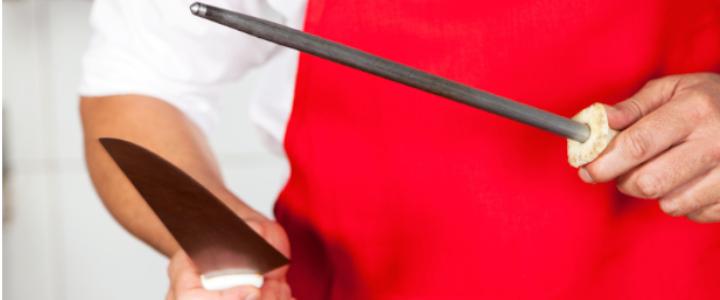The ultimate guide to butcher’s knife steels
When you come to buy a butcher’s knife, you’ll often find that a honing steel is essential to keep it in good condition. After all, if your butcher’s knives aren’t sharp, they’re not going to be a whole lot of use to you. That’s why, as well as stocking a range of butcher’s knives from leading brands like F Dick and Victorinox, we also stock a wide range of knife steels here at Butcher’s Equipment Warehouse. Here’s why they’re so important!
What are butcher’s steels?
Basically, it’s an essential piece of equipment that you need to keep your prized butcher’s knives in good condition, and able to cut with ease. Now, the steels we’re about to discuss are technically honing steels, but they’re often called sharpening steels. (Other names for them include sharpening rods, sharpening sticks, butcher’s steels and chef steels.) You may already know that honing your knife and sharpening it are technically different things, especially if you’ve read our previous post on the topic. However, the usage of ‘sharpening steels’ is so widespread that they’ve become more or less the accepted term amongst many butcher’s - even though what you’re actually doing when you use one is honing your knife, not sharpening it.
Each butcher’s steel is made up of a central tapered metal rod, complete with a handle. The steel used for this rod is harder than that of knife blades (otherwise the honing steel itself wouldn’t be much use, as you can imagine). Most of these rods have shallow grooves down their lengths.

Why butcher’s steels are important
In order to ensure that your cuts are high quality, it’s important to keep your knives in excellent condition and as sharp as they can be, as far as you can reasonably manage.
As for how honing steels help? Well, mostly it all comes down to the burr of the knife. This is the term used to refer to the cutting edge of a high quality knife - specifically where it’s so thin and fine that you can’t actually see the edge. Despite what the layman might think, this burr is not actually straight, but instead edged by tiny, irregular microscopic teeth, which help to slice through the cuts more easily. Since the burr is so fine, it’s ultimately quite pliable, and given enough time and heavy usage, it can ‘roll over’ and become less effective in cutting foods.
This is where you’ll turn to your honing steel, chef’s steel or butcher’s steel (whatever you prefer to call it). What honing the blade does, technically speaking, is ‘realign’ it. In other words, is straightens the burr back to its former position, restoring the sharpness of the knife.
Note that this is different from sharpening the knife. Sharpening it removes a layer of steel entirely, shaping it into a redefined edge. While this is necessary from time to time, ideally you want to be honing your knife far more often than sharpening it. After all, you’ve only got so much blade to shave away! In fact, if you hone your blade frequently enough, the original sharp edge of the burr will be maintained so well that it should save you from having to sharpen the blade at all.
How to hone your butcher’s knife using a knife steel
It’s simple in theory. Place the edge of your blade against the base of the steel, and then slide the blade away from yourself, along the length of the rod. The safest and most effective way to do this is generally at between a 15 to 20 degree angle. You’ll need to do this between five and ten times, and then repeat on the other side. This should restore the blade to its former sharpness. In reality, this takes a bit of practice for inexperienced butchers to properly master, but once you’ve got the basics down it shouldn’t be difficult for you to keep your knives in tip-top condition.
How often should I hone my butcher’s knife?
When it gets dull! There are those who claim to sharpen their knives before every use, but in reality this is probably, at best, unnecessary. Really it just comes down to your personal judgement. When you spot your knife isn’t cutting quite as well, that’s when you should think about honing it.
It’s worth bearing in mind that even the most high quality blades aren’t immune to literally losing their edge over time. It’s not necessarily anything to worry about, and the speed at which it happens is often more to do with how frequently and heavily they’re used, rather than the quality of the blade itself. (Of course, caring for your knives by storing them correctly and cutting on appropriate surfaces can really help slow down the process.) You probably don’t need us to tell you that blunt butcher’s knives aren’t much good in the kitchen or the shop floor, and they can sometimes even be dangerous.
A quick introduction to knife steel materials
Although all knife steels use a central steel rod, they make use of various different types of coatings to keep butcher’s knives sharp. Generally, they’ll fall into one of three categories - steel, ceramic or diamond.
Steel rod
One of the most common types of materials for honing rods, steel rods come in three varieties. There’s the standard grit for hard-cut sharpening, a finer grit commonly used for professional knives, and an ultra-fine grit for honing blades while giving them a polished look. Your instinct might be to automatically seek out the ultra-fine grit, but it’s not a necessity. To be honest, you may well find that either of the other two steels do the job perfectly well!
Ceramic steels
Equally ceramic steels are harder than the blades of butcher’s knives, making the ideal for precise honing. They’re not quite as abrasive as diamond, and are strongly recommended by experts to use for ultra-hard blades.
Diamond steels
Considerably harder than knife steel, this type of material is the hardest and most abrasive that a sharpening rod can have. Now, obviously it’s not the type of diamond you’d necessarily find in a wedding ring - it’s actually referring to the pattern of the grooves on the length of rod itself. Some types of diamond rod also have a thin coating of industrial diamond dust, to make it even easier to get your butcher’s knives back to their former sharpness.
How to choose the best knife steel for your butcher’s knives
We stock a varied range of knife steels in our inventory here at Butcher’s Equipment Warehouse, so we understand it’s not always a straightforward choice to decide which one is best for your butcher’s knife. Happily, there are a few easy ways to narrow down your decision. You’ll need to consider four main factors:
1. The material of the rod
We’ve already explained the key differences between the various types of rod above. One thing to remember is that the rod of a sharpening steel always has a metal core, which is what gives it its strength and reliability. All steel rods have a hardness rating of at least 65 HRC on the Rockwell C scale, so that they can guarantee a minimum level of abrasiveness. The exact level of abrasiveness will be dependent on the coating of the rod: steel, ceramic or diamond.
2. The shape of the rod
The material is far from the only aspect that can differ between various knife steels. The rounded rod is one of the most common types you’ll tend to find, with a standard contact surface (and therefore lighter weight). Then there are the oval rods, whose contact surfaces are even larger than rounded rods. This is great for training up inexperienced cooks or butchers, as there’s a bigger error for margin. Alternatively, you might opt for a flat rod, whose contact surface is even bigger still, resulting in the easiest sharpening of your knives. The tradeoff is that these types of knife steels are often heavier.
Finally, there are squared rods. These types of butcher’s steel have two faces which are a certain grit, while the other two are moulded in a different grit. Obviously you have to be careful when using them, but they are highly versatile when compared to other types of butcher’s steels.
3. The size of the rod itself
You’ll first want to inspect the blades of your butcher’s knives carefully before you commit to buying a knife steel. Buying one that’s too short is undesirable for a number of reasons - for starters, it won’t be nearly as effective at honing your blades. What’s more, due to the motion required when honing them, having a steel that’s too short can even be slightly dangerous.
4. The hardness of your blade
Once again, you need to inspect the blades you’ll be sharpening before you can make an informed decision on this. The hardness of your blades will affect how abrasive your chef’s steel needs to be, and what sort of coating it’ll need on it. The harder your knife, the more abrasive your steel has to be. If your butcher’s knife isn’t particularly hard, you’ll probably find a basic steel model will suit your needs fine. If you’ve got an ultra-hard blade, though, it’s worth looking at the most abrasive options, like a diamond honing steel.
Shop for knife steels right here
We’ve got an expansive selection of knife steels, butcher’s steels and chef steels right here at Butcher’s Equipment Warehouse, so whatever your specific requirements you can count on us to have something that matches them. We also have a further range of knife edge maintenance tools and even some electric knife sharpeners, although be aware that (as we’ve said), it’s important to know the difference between honing and sharpening before you buy! You can explore our range through the links above, or give us a quick call on 01254 427 761, and we’ll be happy to advise.




